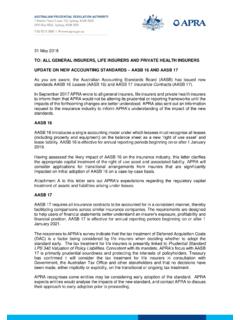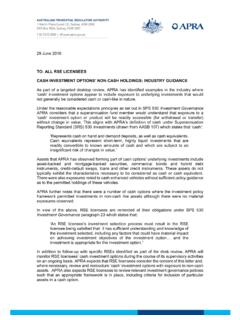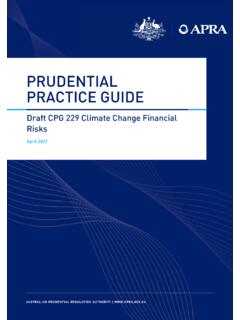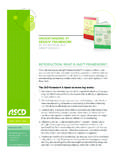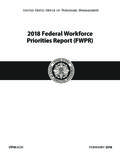Transcription of AUSTRALIAN PRUDENTIAL REGULATION AUTHORITY
1 AUSTRALIAN PRUDENTIAL REGULATION AUTHORITY . 1 Martin Place (Level 12), Sydney, NSW, 2000. GPO Box 9836, Sydney, NSW, 2001. T 02 9210 3000 | W 18 September 2019. TO: GENERAL INSURERS AND LIFE INSURERS. INSURANCE RECOVERY PLANNING THEMATIC REVIEW KEY OBSERVATIONS. The purpose of this letter is to outline APRA's observations from a recent recovery planning thematic review including areas of better practice. APRA conducted this thematic review with a group of in-scope large and medium-sized general insurers and life insurers (insurers). APRA assessed their recovery plans against the recovery planning guidance (the Guidance 1). provided to the in-scope insurers. The Guidance is available to insurers through their APRA.
2 Supervision team. Building recovery and resolution capability, through improved planning, will remain a key strategic priority for APRA over the coming years. A recovery plan comprises a menu of options designed by a financial institution to enable it to survive a financial shock and restore itself to a sound financial condition without the need to seek public sector support. APRA will use the outcomes of the thematic review to inform its development of a PRUDENTIAL framework for recovery and resolution, which will include a PRUDENTIAL standard and accompanying guidance. APRA plans to consult on this framework next year. APRA's key observations from the thematic review, including areas of better practice, are set out in Attachment A.
3 APRA encourages insurers to consider these observations in the ongoing development of credible recovery plans. If you have any questions, please contact your APRA supervision team. Yours sincerely Geoff Summerhayes Executive Board Member 1 The Guidance was developed using the Financial Stability Board (FSB) Key Attributes of Effective Resolution Regimes for Financial Institutions, and the International Association of Insurance Supervisors (IAIS) standard on recovery planning (ICP 16). ATTACHMENT A: KEY OBSERVATIONS. This section provides a summary of APRA's key observations from the thematic review, including areas of better practice. APRA encourages insurers to consider the better practice examples alongside the existing Guidance in the ongoing development of credible recovery plans (referred to as the plan(s)).
4 APRA observed that the recovery planning process has assisted in-scope insurers to advance their overall approach to risk management, and to build a better understanding of the importance of recovery planning. However, there remain considerable areas for improvement before in-scope insurers can be assessed to have credible plans in place that are effectively integrated with the risk management framework. APRA considers the usability of the recovery plan is a key factor when assessing its credibility. APRA expects recovery planning to be a dynamic process, where the plans continue to be assessed, tested and improved with ongoing board oversight. 1. Governance Robust governance arrangements are essential both for effectively developing and maintaining the recovery plan, and for ensuring appropriate monitoring and escalation processes are in place to allow for timely implementation of recovery options.
5 I. Integration with risk management framework Recovery planning can be viewed as being at the more extreme end of the risk management continuum. Many of the plans assessed are not yet effectively integrated with the broader risk management framework. APRA expects the elements of the recovery plan including the escalation procedures, trigger framework, recovery options and communication strategy to be consistent and aligned with other risk management documents. Figure 1 provides an illustrative example of how recovery planning fits into the crisis continuum. Better practice examples include: Integration with and cross-referencing to other risk management documents, where appropriate. This includes ensuring that the governance arrangements for escalation and activation of the plan are well understood and coordinated across the institution and recovery options can be implemented in a timely manner.
6 AUSTRALIAN PRUDENTIAL REGULATION AUTHORITY 2. Consideration of how the communication strategy in the recovery plan is aligned with the insurer's broader approach to effective communication. ii. Monitoring, escalation and activation processes Weaker plans lack clarity on the processes for monitoring and escalating emerging issues. It is not clear how escalation procedures would work in practice, and the mapping of roles and responsibilities of key stakeholders needs to be strengthened. Better practice examples include: Clear articulation of the link between the trigger framework and the governance arrangements within the plan. Stronger plans make use of diagrams and flowcharts to illustrate the link between their trigger framework and governance arrangements.
7 Clear accountability mapping of the roles and responsibilities of key stakeholders for each stage of the monitoring and escalation process. Strong and clear decision-making mechanisms in place for activating the plan, and for selecting and implementing recovery options. Well-defined processes in place for how and when to notify regulators (local and foreign, where relevant), regarding an emerging crisis and any proposed response under the plan. iii. Operational testing Most in-scope insurers have not yet developed a sufficient framework for operational testing of plans. Regular operational testing of the plan is important, particularly to build confidence that the governance and escalation procedures in the plan are well understood, including by the board and senior management, and could be implemented in a timely manner in a crisis.
8 APRA considers it prudent for insurers to conduct regular (at least annual) dry-runs and training exercises focusing on internal escalation processes, the formation and functioning of crisis management teams and determination of communication strategies. Better practice examples include: A planned and documented approach to regular operational testing of the plan, including identification of the key factors to be tested. Incorporation of the lessons learnt from operational testing into the plan to ensure its ongoing development. 2. Trigger frameworks The trigger framework should operate in a manner which reflects the escalating nature of stress events, so as to facilitate timely contingency planning and the intensifying of responses as the severity increases.
9 I. Range of metrics A number of plans rely on a single capital trigger for activation of the plan instead of considering the use of a wider range of metrics to identify emerging risks across a variety of AUSTRALIAN PRUDENTIAL REGULATION AUTHORITY 3. areas. The trigger framework should be aligned with the insurer's broader risk management framework, and should be sensitive to deteriorating conditions across a variety of areas. Better practice examples include: Incorporating a wide variety of early warning indicators (EWIs) and triggers. For example, the trigger framework can benefit from inclusion of metrics relating to capital, profitability and other performance metrics, sensitivity and volatility factors, reinsurance, external factors, liquidity, and the insurer's operational conditions.
10 Considering a range of metrics, which include quantitative and qualitative criteria and include leading and lagging indicators, where possible. ii. Timely trigger points Stronger plans make use of a staggered trigger framework, so that the plan operates in a cascading manner to trigger intensifying responses as the severity of a stress increases, and does not rely on a single trigger point. Better practice examples include: Indicators and triggers are calibrated early enough to allow sufficient lead time to plan for and implement recovery options. For example, where a hard capital recovery trigger point is utilised, it is calibrated to automatically activate the plan or prompt a decision to activate the plan well before the regulatory minimum is reached.
